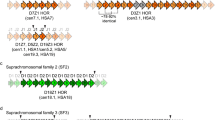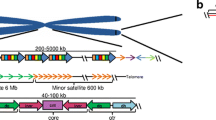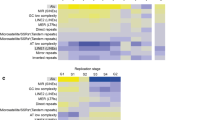Abstract
Using in vitro immuno-selected retinoic acid response elements, we have isolated mouse genomic clones containing major (γ) satellite DNA repeats that are considered as typical of chromosome centromeres. Several cDNA clones were then isolated from a F9 cell cDNA library and were found to harbor variants of the 234-base pair consensus γ satellite monomer. In Northern analysis, these satellite DNA sequences hybridized predominantly to an ≈1.8-kb RNA species in polyadenylated RNA from P19 cells. These transcripts were strongly repressed by retinoic acid, and nuclear run-on assays revealed that this repression was, at least in part, mediated at the transcriptional level. Satellite transcripts were also detected in HeLa cells, where they were similarly down-regulated by retinoids. Heterogeneously sized satellite transcripts were detected in RNA from specific mouse tissues, such as fetuses (but not placenta), adult liver, and testis. In situ hybridization analysis revealed that satellite transcripts are generated from opposite DNA strands and are differentially expressed in cells of the developing central nervous system as well as in adult liver and testis. These data may have implications on retinoic acid-mediated transcriptional regulation and centromere function.
Similar content being viewed by others
References
Auffray, C., Rougeon, F. (1980). Purification of mouse immunoglobulin heavy-chain messenger RNAs from total myeloma tumor RNA. Eur. J. Biochem. 107, 303–314.
Buttner, K.A., Lo, C.W. (1986). High frequency DNA rearrangements associated with mouse centromeric satellite DNA. J. Mol. Biol. 187, 547–556.
Chomezynski, P., Sacchi, N. (1987). Single-step method of RNA isolation by guanidinium thiocyanate-phenol-chloroform extraction. Anal. Biochem. 162, 156–159.
Choo, K.H., Brown, R., Webb, G., Craig, I.W., Filby, R.G. (1987). Genomic organization of human centromeric alpha satellite DNA: Characterization of a chromosome 17 alpha satelite sequence. DNA 6, 297–305.
Décimo, D., Georges-Labouesse, E., Dollé, P. (1994). In situ hybridization of nucleic acid probes to cellular RNA. In Gene Probes: A Practical Approach, Vol. II, B.D. Hames, S.J. Higgins, eds. (Oxford, UK: Oxford University Press), in press.
De Luca, L.M. (1991). Retinoids and their receptors in differentiation, embryogenesis, and neoplasia. FASEB J. 5, 2924–2932.
deThé, H., Vivanco-Ruiz, M.d.M., Tiollais, P., Stunnenberg, H., Dejean, A. (1990). Identification of a retinoic acid responsive element in the retinoic acid receptor β gene. Nature 343, 77–180.
Diaz, M.O., Barsacchi-Pilone, G., Mahon, K.A., Gall, J.G. (1981). Transcripts from both strands of satellite DNA occur on lampbrush chromosome loops of the newt Notophthalamus. Cell 24, 649–659.
Draetta, G. (1990). Cell cycle control in eukaryotes: molecular mechanisms of cdc2 activation. Trends Biochem. Sci. 15, 378–383.
Durand, B., Saunders, M., Leroy, P., Rees, J., Chambon, P. (1992). Alltrans and 9-cis retinoic acid induction of CRABPII transcription is mediated by RAR-RXR heterodimers bound to DR1 and DR2 repeated motifs. Cell 71, 73–85.
Feinberg, A.P., Vogelstein, B. (1983). A technique for radiolabeling restriction endonuclease fragments to high specific activity. Anal. Biochem. 132, 6–13.
Gaubatz, J.W., Cutler, R.G. (1990). Mouse satellite DNA is transcribed in senescent cardiac muscle. J. Biol. Chem. 265, 17753–17758.
Grosveld, F.G., Lund, T., Murray, E.J., Mellor, A.L., Dahl, H.H.M., Flavell, R.A. (1982). The construction of cosmid libraries which can be used to transform eukaryotic cells. Nucleic Acids Res. 10, 6715–6732.
Haigwood, N.L., Jahn, C.L., Hutchinson, A., Edgell, M.H. (1981). Location in three repetitive sequence families found in BALB/c adult β globin genes. Nucleic Acids Res. 9, 133–1150.
Horz, W., Altenburger, W. (1981). Nucleotide sequence of mouse satellite DNA. Nucleic Acids Res. 9, 683–696.
Howell, J.M., Thompson, J.N., Pitt, G.A.J. (1963). Histology of the lesions produced in the reproductive tract of animals fed a diet deficient of vitamin A acid. I. The male rat. J. Reprod. Fertil. 5, 159–167.
Jackson, M.S., Mole, S.E., Ponder, B.A.J. (1992). Characterization of a boundary between satellite III and alphoid sequences on human chromosome 10. Nucleic Acids Res. 20, 4781–4787.
Jagadeeswaran, P., Forget, B.G., Weissman, S.M. (1981). Short interspersed repetitive DNA elements in eucaryotes: transposable DNA elements generated by reverse trancription of RNA pol III transcripts? Cell 26, 141–142.
Johnson, D.J., Kroisel, P.M., Klapper, H.J., Rosenkranz, W. (1992). Microdissection of a human marker chromosome reveals its origin and a new family of centromeric repetitive DNA. Hum. Mol. Genet. 1, 741–747.
Krayev, A.S., Kramerov, D.A., Skryabin, K.G., Ryskov, A.P., Bayev, A.A., Georgiev, G.P. (1980). The nucleotide sequence of the ubiquitous repetitive DNA sequence B1 complementary to the most abundant class of mouse fold-back RNA. Nucleic Acids Res. 8, 1201–1215.
Leid, M., Kastner, P., Chambon, P. (1992). Multiplicity generates diversity in the retinoic acid signalling pathways. Trends Biochem. Sci. 17, 427–433.
Linial, M., Gunderson, N., Groudine, M. (1985). Enhanced transcription of c-myc in bursal lymphoma cells requires continuous protein synthesis. Science 230, 1126–1132.
Lipkin, S.M., Nelson, C.A., Glass, C.K., Rosenfeld, M.G. (1992). A negative retinoic acid response element in the rat oxytocin promoter restricts transcriptional stimulation by heterologous transactivation domains. Proc. Natl. Acad. Sci. USA 89, 1209–1213.
Lufkin, T., Lohnes, D., Mark, M., Dierich, A., Gorry, P., Gaub, M.-P., LeMeur, M., Chambon, P. (1993). High postnatal lethality and testis degeneration in retinoic acid receptor α mutant mice. Proc. Natl. Acad. Sci. USA 90, 7225–7229.
Maraia, R.J. (1991). The subset of mouse B1 (Alu-equivalent) sequences expressed as small processed cytoplasmic transcripts. Nucleic Acids Res. 19, 5695–5702.
Nagpal, S., Saunders, M., Kastner, P., Durand, B., Nakshatri, H., Chambon, P. (1992). Promoter context- and response element-dependent specificity of the transcriptional activation and modulating functions of retinoic acid receptors. Cell 70, 1007–1019.
Oakberg, J. (1956). Duration of spermatogenesis in the mouse and timing of stages of the cycle of the seminiferous epithelium. Am. J. Anat. 99, 504–516.
Potter, S.S., Jones, R.S. (1983). Unusual junctions of human alphoid satellite DNA with contiguous non-satellite sequences: sequence analysis of junction regions. Nucleic Acids Res. 11, 3137–3153.
Ragsdale, C.W. Jr., Brockes, J.P. (1991). Retinoids and their targets in vertebrate development. Curr. Opin. Cell Biol. 3, 928–934.
Rudert, F., Gronemeyer, H. (1993). Retinoic acid-response elements with a highly repetitive structure isolated by immuno-selection from genomic DNA. J. Steroid Biochem. Mol. Biol. 46, 121–133.
Rudert, F., Garnier, J.-M., Schuhbaur, B. (1993). Cloning of a pseudogene and cDNA encoding a 17-kDa ribosomal protein from mouse: structure and regulation of expression. Gene 133, 249–254.
Schrewe, H., Thompson, J., Bona, M., Hefta, L.J.F., Maruya, A., Hassauer, M., Shively, J.E., von Kleist, S., Zimmermann, W. (1990). Cloning of the complete gene for the carcinoembryonic antigen: analysis of its promoter indicates a region conveying cell type-specific expression. Mol. Cell. Biol. 10, 2738–2748.
Sleigh, M.J. (1992). Differentiation and proliferation in mouse embryonal carcinoma cells. BioEssays 14, 769–775.
Smith, G.P. (1976). Evolution of repeated DNA sequences by unequal crossover. Science 191, 528–535.
Stephenson, E.C., Erba, H.P., Gall, J.G. (1981). Histone gene clusters of the newt Notophthalamus are separated by long tracts of satellite DNA. Cell 24, 639–647.
Van Arsdell, S.W., Denison, R.A., Bernstein, L.B., Weiner, A.M. (1981). Direct repeats flank three small nuclear RNA pseudogenes in the human genome. Cell 26, 11–17.
Van Pelt, H.M.M., De Rooij, D.G. (1991). Retinoic acid is able to reinitiate spermatogenesis in vitamin A-deficient rats and high replicate doses support the full development of spermatogenic cells. Endocrinology 128, 697–704.
Vasios, G.W., Gold, J.D., Petkovich, M., Chambon, P., Gudas, L.J. (1989). A retinoic acid-responsive element is present in the 5′ flanking region of the laminin B1 gene. Proc. Natl. Acad. Sci. USA 86, 9099–9103.
Vissel, B., Choo, K.H. (1989). Mouse major (γ) satellite DNA is highly conserved and organized into extremely long tanden arrays: implications for recombination between nonhomologous chromosomes. Genomics 5, 407–414.
Wevrick, R., Willard, V.P., Willard, H.F. (1992). Structure of DNA near long tandem arrays of alpha satellite DNA at the centromere of human chromosome 7. Genomics 14, 912–923.
Willard, H.F. (1990). Centromeres of mammalian chromosomes. Trends Genet. 6, 410–416.
Wong, A.K.C., Rattner, A.B. (1988). Sequence organization and cytological localization of the minor satellite of mouse. Nucleic Acids Res. 16, 11645–11661.
Zelent, A., Mendelsohn, C., Kastner, P., Krust, A., Garnier, J.-M., Ruffenach, F., Leroy, P., Chambon, P. (1991). Differentially expressed isoforms of the mouse retinoic acid receptor β are generated by usage of two promoters and alternative splicing. EMBO J. 10, 71–81.
Zimmermann, W., Ortlieb, B., Friedrich, R., von Kleist, S. (1987). Isolation and characterization of cDNA clones encoding the human carcinoembryonic antigen reveal a highly conserved repeating structure. Proc. Natl. Acad. Sci. USA 84, 2960–2964.
Author information
Authors and Affiliations
Rights and permissions
About this article
Cite this article
Rudert, F., Bronner, S., Garnier, J.W. et al. Transcripts from opposite strands of γ satellite DNA are differentially expressed during mouse development. Mammalian Genome 6, 76–83 (1995). https://doi.org/10.1007/BF00303248
Received:
Accepted:
Issue Date:
DOI: https://doi.org/10.1007/BF00303248




